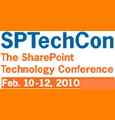So, a requirement popped up to allow the business to store “Contact Us” information in SharePoint and use workflows to manually send emails to the people who submitted the contact information. Very easy.. nothing spectacular. They also wanted the ability to send pre-formatted email templates as responses. Also fairly easy to do creating an SPD workflow for each template, right? Well.. what do you do so that you don’t have to open up SPD every time the user wants to add or modify a template? I came up with the following solution. You could take what I did here and build upon it to make it much more elaborate. I’m sure you could format the emails more professionally. You could auto populate more fields like the subject and signature.
In this article I’ll describe some of the ways that SharePoint can reduce the effort to create, manage and retrieve documents and increase their value, as smart documents, to both your firm and its clients.
Another quick little fun thing today. Many times you might want (need) to hide the “New” button on a list toolbar. You know the one I mean? Why would you want to do such a thing? For example on a project I’m building I actually call the NewForm.aspx page with a querystring because I want to pre-populate my form with some vales. As such, I don’t want users to create new items in a list without these references and since they have to come from another list I’m left with the problem of trying to restrict them from creating new items but still offer them the ability to use the features of the list like alerts, exporting to spreadsheets, etc. Yes, the “New” button isn’t available for readers of a list but for contributors it is and for admins you can’t just turn some of this stuff off easily.
At the Microsoft SharePoint Conference 2009, I had the distinct pleasure to present the Introduction to SharePoint Designer 2010 session. The early estimates are that over 1000 people attended that session. I personally had a real good time talking about SharePoint Designer since, aside from the facts that it’s my favorite tool to customize SharePoint and that I co-authored the book on SharePoint Designer 2007, so many enhancements have been made to this product that I didn’t have to use the “maybe this feature will be included in the next version” answer even once in the session Q&A! Awesome!
List administrators should be able to send e-mails to all the approved and registered users specifying some filters. For instance, the list administrator should be capable of sending e-mails to all the registered users from Canada. In this article, I will show you how to implement this requirement using Microsoft Word Mail Merge.
This is the fifth article in a multipart series that is intended to help you create mailing lists for your SharePoint sites or blogs without writing a single line of .NET Code. In the introductory article, I listed the project initiatives, requirements, and objectives. In Part 1, I created a secured backend where we will store the subscribers’ contacts. In Part 2, I configured the ‘Contact’ content type, created a subscription form for the mailing list and did some simple customizations to it. In Part 3, I utilized the thrilling DataFormWebPart to further extend and enhance the subscription form to meet the project requirements. In Part 4, I implemented requirement # 3 by creating a list that comprises the names of all the countries of the world and a lookup field that gets its values from this list.
This is the fourth article in a multipart series that is intended to help you create mailing lists for your SharePoint sites or blogs without writing a single line of .NET Code. In the introductory article, I listed the project initiatives, requirements, and objectives. In Part 1, I created a secured backend where we will store the subscribers’ contacts. In Part 2, I configured the ‘Contact’ content type, created a subscription form for the mailing list and did some simple customizations to it. In Part 3, I utilized the thrilling DataFormWebPart to further extend and enhance the subscription form to meet the project requirements.
Recently I’ve been involved in the development of a SharePoint 2007 solution using InfoPath and Forms Services. The purpose of the solution was collection of employee questionnaire data using one of several forms designed as a multi-page survey.
SharePoint 2010 comes with a bunch of web 2.0 features, tags, tag clouds, rating, social bookmarking and enhanced blogs and wikis. What I really missed in SharePoint 2007 were tags and tag clouds. On the other hand this was a free space for developers like me, see Power Tag Cloud ;-) My experience with SharePoint 2003 already showed that text, dropdowns and lookup columns are too inflexible and people tend to over categorize in the conception stage.
Everyone with an intermediate level of knowledge with SharePoint knows that there are 3 ways to create workflows that act on SharePoint lists/libraries. In ascending order of complexity and flexibility they are: OOTB SharePoint workflows, SharePoint designer workflows and custom developed Visual Studio workflows.





